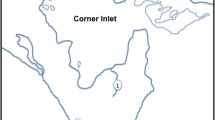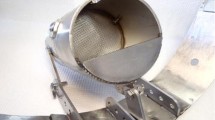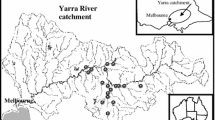Abstract
Urban stormwater samples were collected from five aquatic systems in Melbourne, Australia, on six occasions between October 2011 and March 2012 and tested for 30 herbicides and 14 trace metals. Nineteen different herbicides were observed in one or more water samples from the five sites; chemicals observed at more than 40% of sites were simazine (100%), MCPA (83%), diuron (63%) and atrazine (53%). Using the toxicity unit (TU) concept to assess potential risk to aquatic ecosystems, none of the detected herbicides were considered to pose an individual, group or collective short-term risk to fish or zooplankton in the waters studied. However, 13 herbicides had TU values suggesting they might have posed an individual risk to primary producers at the time of sampling. Water quality guideline levels were exceeded on many occasions for Cd, Cu, Cr, Pb and Zn. Similarly, RQmed and RQmax exceeded 1 for Cd, Cr, Cu, Mn, Ni, Pb, V and Zn. Almost all the metals screened exceeded a log10TU of −3 for every trophic level, suggesting that there may have been some impact on aquatic organisms in the studied waterbodies. Our data indicate that Melbourne’s urban aquatic environments may be being impacted by approved domestic, industrial and sporting application of herbicides and that stormwater quality needs to be carefully assessed prior to reuse. Further research is required to understand the performance of different urban stormwater wetland designs in removing pesticides and trace metals. Applying the precautionary principle to herbicide regulation is important to ensure there is more research and assessment of the long-term ‘performance’ standard of all herbicides and throughout their ‘life cycle’. Implementing such an approach will also ensure government, regulators, decision makers, researchers, policy makers and industry have the best possible information available to improve the management of chemicals, from manufacture to use.


Similar content being viewed by others
References
Allinson G, Zhang P, Bui A, Allinson M, Rose G, Marshall M, Pettigrove V (2015) Pesticide and trace metal occurrence and aquatic benchmark exceedances in surface waters and sediments of urban wetlands and retention ponds in Melbourne, Australia. Environ Sci Pollut Res 22:10214–10226
ANZECC and ARMCANZ (2000) Australian and New Zealand guidelines for fresh and marine water quality. Australian and New Zealand Environment and Conservation Council and Agriculture and Resource Management Council of Australia and New Zealand, Canberra, Australia
APVMA (2016) Final pesticide and veterinary medicines product sales 2014–15 Financial Year. Commonwealth of Australia Gazette No APVMA 6, Tuesday 22 March 2016. Australian Pesticides and Veterinary Medicines Authority, Canberra, Australia
Australian Government (1992). National strategy for ecological sustainable development. Available at: www.environment.gov.au/about/esd/publications/strategy/intro.html #WIESD
Baas J, Jager T, Kooijman SALM (2009) A model to analyze effects of complex mixtures on survival. Ecotox Environ Safe 72:669–676
Bollmann UE, Vollertsen J, Carmeliet J, Bester K (2014) Dynamics of biocide emissions from buildings in a suburban stormwater catchment—concentrations, mass loads and emission processes. Water Res 56:66–76
Bundschuh M, Goedkoop W, Kreuger J (2014) Evaluation of pesticide monitoring strategies in agricultural streams based on the toxic-unit concept—experiences from long-term measurements. Sci Total Environ 484:84–91
DeLorenzo ME, Thompson B, Cooper E, Moore J, Fulton MH (2012) A long-term monitoring study of chlorophyll, microbial contaminants, and pesticides in a coastal residential stormwater pond and its adjacent tidal creek. Environ Monit Assess 184:343–359
Ensminger MP, Budd R, Kelley KC, Goh KS (2013) Pesticide occurrence and aquatic benchmark exceedances in urban surface waters and sediments in three urban areas of California, USA, 2008–2011. Environ Monit Assess 185:3697–3710
European Commission (2011) Implementing regulation (EC) no 1107/2009 of the European Parliament and of the Council as regards uniform principles for evaluation and authorisation of plant protection products. Off J Eur L155:127–175
Ferreira V, Koricheva J, Duarte S, Niyogi DK, Guréold F (2016) Effects of anthropogenic heavy metal contamination on litter decomposition in streams: a meta-analysis. Environ Pollut 210:261e–2270
Frost L, Gaynor A, Gregory J, Morgan R, O’Hanlon S, Spearritt P, Young P (2016) Water, history and the Australian city: urbanism, suburbanism and water in a dry continent, 1788–2015. Cooperative Research Centre for Water Sensitive Cities, Melbourne, Australia
Hatt BE, Flander L, Mitchell VG (2006) Quantifying stormwater recycling risks and benefits: heavy metals review. Institute for Sustainable Water Resources Report 06/04, Monash University
Liess M, von der Ohe PC (2005) Analyzing effects of pesticides on invertebrate communities in streams. Environ Toxicol Chem 24(4):954–965
Luoma SN, Rainbow PS (2008) Metal contamination in aquatic environments: science and lateral management. Cambridge University Press, Cambridge
Mackintosh TJ, Davis JA, Thompson RM (2016) Tracing metals through urban wetland food webs. Ecol Eng 94:200–213
Melbourne Water (2016). Design, construction and establishment of constructed wetlands: design manual. A1: Vision, core outcomes and aspirational outcomes. Available online: http://www.melbournewater.com.au/Planning-and-building/Standards-and-specifications/design-wsud/Pages/Constructed-wetlands-design-manual.aspx Last Accessed 28 July 2016
Melbourne Water (2014). Water use data. Available online: www.melbournewater.com.au/waterdata/wateruse/Pages/default.aspx. Last Accessed 8 Feb 2014
Melbourne Water (2012). Draft stormwater strategy 2012. Available online: http://consultation.melbournewater.com.au/document/show/31. Last Accessed 8 Feb 2014
NRMMC, EPHC & NHMRC (2009). Australian guidelines for water recycling stormwater harvesting and reuse. National Water Quality Management Strategy Document No 23, Natural Resource Management Ministerial Council, the Environment Protection and Heritage Council, and the National Health and Medical Research Council, Canberra
Page D, Dillon P, Mueller J, Bartkow M (2010) Quantification of herbicide removal in a constructed wetland using passive samplers and composite water quality monitoring. Chemosphere 81(3):394–399
Page D, Miotliński K, Gonzalez D, Barry K, Dillon P, Gallen C (2014) Environmental monitoring of selected pesticides and organic chemicals in urban stormwater recycling systems using passive sampling techniques. J Contam Hydrol 158:65–77
Raina R, Etter ML, Buehler K, Starks K, Yowin Y (2011) Phenoxyacid herbicides in stormwater retention ponds: urban inputs. Am J Anal Chem 2:962–970
Schäfer RB, Pettigrove V, Rose G, Allinson G, Wightwick A, von der Ohe PC, Shimeta J, Kuhne R, Kefford BJ (2011) Effects of pesticides monitored with three sampling methods in 24 sites on macroinvertebrates and microorganisms. Environ Sci Technol 45:1665–1672
Serrano L, DeLorenzo ME (2008) Water quality and restoration in a coastal subdivision stormwater pond. J Environ Manag 88:43–52
Sumner ME, Rengasamy P, Naidu R (1998) Sodic soils: a reappraisal. In: Sumner ME, Naidu R (eds) Sodic soils: distribution, properties, management, and environmental consequences. Oxford University Press, New York
Thomatou A-A, Zacharias I, Hela D, Konstantinou I (2013) Determination and risk assessment of pesticide residues in lake Amvrakia (W. Greece) after agricultural land use changes in the lake's drainage basin. Int J Environ Anal Chem 93(7):780–799
Tom M, Fletcher TD, McCarthy DT (2014) Heavy metal contamination of vegetables irrigated by urban stormwater: a matter of time? PLoS One 9(11):e112441. doi:10.1371/journal.pone.0112441
Wightwick AM, Allinson G (2007) Pesticide contamination of waterways within agricultural areas of Victoria: a review. Aus J Ecotoxicol 13:91–112
Wong THF, Brown RR (2009) The water sensitive city: principles for practice. Water Sci Technol 60(3):673–642
Zhang P, Bui A, Rose G, Allinson G (2014) Mixed-mode solid-phase extraction coupled with liquid chromatography tandem mass spectrometry to determine phenoxy acid, sulfonylurea, triazine and other selected herbicides at nanogram per litre levels in environmental waters. J Chromatography A 1325:56–64
Acknowledgements
The research was supported by the then Department of Primary Industries (project nos. 08160 and 06889), Melbourne Water, and by the Centre for Aquatic Pollution, Identification and Management (CAPIM). At the time of this study, CAPIM received foundation funding from The Victorian Science Agenda Investment Fund managed by the Department of Business and Innovation (DBI) (www.innovation.vic.gov.au) with additional funding from Melbourne Water, Department of Primary Industries (Victoria) and Environment Protection Authority (Victoria). GA thanks the RMIT Foundation for an International Research Exchange Fellowship and Dr Judy Blackbeard (Melbourne Water) for supporting this project.
Author information
Authors and Affiliations
Corresponding author
Ethics declarations
Conflict of interest
The authors declare that they have no conflict of interest.
Additional information
Responsible editor: Ester Heath
Electronic supplementary material
ESM 1
(DOCX 439 kb)
Rights and permissions
About this article
Cite this article
Allinson, M., Zhang, P., Bui, A. et al. Herbicides and trace metals in urban waters in Melbourne, Australia (2011–12): concentrations and potential impact. Environ Sci Pollut Res 24, 7274–7284 (2017). https://doi.org/10.1007/s11356-017-8395-9
Received:
Accepted:
Published:
Issue Date:
DOI: https://doi.org/10.1007/s11356-017-8395-9




